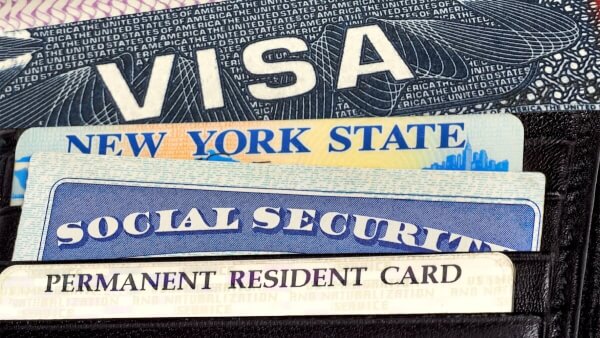Transferring your international driver's license to the US: step-by-step
Your full guide to updating your foreign driver's license to the US.

As an American Green Card holder you’re granted permanent residency (PR) in the US, and can even apply to naturalize as an American citizen after a few years.
Most Green Card holders qualify for permanent residency through the family route. That means a relative who is already a US citizen or PR themselves sponsors their application through the family based Green Card process.
This guide covers all you need to know about the USCIS family based Green Card — and we’ll also introduce Wise and the Wise Multi-currency Account as good ways to cut the costs of paying for your application from abroad.
If you are the family member of a US citizen or Green Card holder, you may be entitled to apply for a Green Card of your own. Whether or not you’re eligible will depend on your relationship¹. There are also caps and restrictions on how many Green Cards are issued in different relationship categories, which can mean a long wait to get a family based Green Card for some. We’ll cover all this, including the family based Green Card timeline, in just a moment.
If you’re a US citizen and plan to marry a foreigner, your fiancé will also be able to apply for a Green Card, as will their children. In this case the Green Card category is known as a K1 or K2 non-immigrant or a marriage based Green Card. It’s good to know that in this case the Green Card will likely be issued on a conditional basis to ensure the marriage is genuine.
| Learn more: conditional Green Card |
|---|
It is important to understand the family based Green Card categories so you know which you’ll fall into. The basic categories are:
The first two categories — immediate relative² and preference relative³ — are the 2 most common categories under the family based eligibility route. We’ll break these down in more detail next.
To be classed as an immediate relative you must be a US citizen’s spouse, parent or unmarried child aged under 21. There are no limits to the number of immediate relative Green Cards that are issued. That means no long waiting times — and a slightly different application process compared to the other family based Green Card visa routes.
Preference relatives for a family based Green Card include:
There are caps on the different preference categories, which means there are long wait times for some applicants. We’ll break these preference categories down later.
As you can see from this list, not all relatives of US citizens and PRs can apply for a Green Card. Unfortunately, other relatives like grandparents, aunts, nephews and so on are not covered by this Green Card eligibility option.
An accompanying relative is anyone making a Green Card application based on their relationship to someone who is immigrating to the US. You’ll be classed as an accompanying relative if you’re applying on the basis of your relationship to a Green Card holder, for example.
To apply for a family based Green Card you’ll need to have a sponsor who is a US citizen or Green Card holder themselves. The process is slightly different depending on whether you’re already in the US or not. If you’re not already in the US, you must follow the consular processing route⁴. For relatives who are already in the US, their application will go through USCIS directly.
In both cases, to apply for a Green Card you’ll need an immigrant visa. Annually, 226,000 family based immigrant visas are issued, and there are caps on the numbers of visas issued across different preference categories and different countries of origin. Applicants from countries which have a strong history of immigration into the US may face longer waits due to limits aimed at maintaining a mix of immigrants from all over the world. At the time of writing this means that applicants from countries including China, Vietnam, the Philippines, India and Mexico could wait longer.
Let’s take a look at the Green Card family preference categories and how visas are allocated across them:
First preference relatives are a US citizen’s unmarried children aged over 21. A total of 23,400 visas are allocated to this category — plus any visas which are not required by fourth preference applicants.
The second preference Green Card category actually splits down into 2 further groups — F2A covers spouses and children (unmarried and under 21 years of age) of lawful permanent residents.
Across the total of the second preference category (F2A and F2B) there are usually 114,200 available visas. 77% of these — 87,934 visas in total — are for the F2A group.
The country restrictions we outlined above do not apply to 75% of these visas, which means that applicants in this category often have a relatively short wait time to have their Green Card application processed.
F2B second preference applicants are the unmarried sons and daughters (21 years of age and older) of lawful permanent US residents.
The remaining 23% of visas in this category — 26,266 visas in total, are available for this preference group.
23,400 visas annually — plus any visa allocations not used by the first and second preference categories — are available for F3 category applicants. Third preference applicants are the married sons and daughters of US citizens.
F4 — fourth preference Green Card — applicants are the brothers and sisters of US citizens (if the US citizen is 21 years of age and older). Each year there are 65,000 visas available for this category — plus any other visa allocation not already used by other categories.

There are slightly different processes to follow when applying for a family based Green Card in the US compared to someone who is not already in the country.
|
|---|
If you’re applying for a family based Green Card and you’re not an immediate relative, you’ll need to understand the visa bulletin⁸ to know when you can submit your full paperwork pack and Form I-485.
The visa bulletin was introduced to help manage the flow of Green Card applications, and make sure people were aware of the likely wait times involved. When your sponsor has successfully filed Form I-130 on your behalf, you’ll be given what’s known as a priority date. That’s usually the date your petition was processed by USCIS.
Every month USCIS releases a visa bulletin which states which Green Card applicants can continue their applications, based on the number of immigrant visas that are — or are anticipated to be — available. It’s a little like taking a ticket and waiting in line. The priority dates in the visa bulletin move forward as applications are processed: you wait until your priority date shows up, and then you can move on to Form I-485 and the next stage of your application.
| Read all about the Visa Bulletin here |
|---|
One of the last steps in your Green Card application process is to attend a Green Card interview. This will be with USCIS if you’re in the US already, or at your local consulate or embassy if not.
The Green Card interview is your opportunity to talk through your application, provide any evidence required and show you’re eligible for US permanent residency.
| Learn more about preparing for and attending the Green Card interview here |
|---|
Navigating immigration processes can be confusing. Here are the answers to some common questions to help you get your family based Green Card arranged.
How long you’ll wait for your family-based Green Card depends on which eligibility category you fall into and, in some cases, the country you’re from. If you’re applying in a category which has annual caps, or you’re from a country which traditionally has high immigration into the US you can expect it to take a while for a visa to become available. Waits of 10 years are not uncommon.
| Learn more about how long it takes to get a Green Card here |
|---|
The costs involved in getting your Green Card vary based on your eligibility category and whether or not you’re already in the US. Fees include a filing fee for the immigrant petition, another charge for Form I-485, biometric fees and a medical exam. There’s a handy USCIS fee calculator online which you can use to estimate your costs⁹ — or you can read more about the costs of getting a Green Card, here.
| 💰 Save money when you pay for your Green Card from abroad, by using Wise. Get currency exchange which uses the real mid-market exchange rate, and low transparent fees — every time you need to send an international transfer. |
|---|
You’ll need to provide a range of documents as part of your Green Card application, including your own ID and birth certificate to show your relationship to your sponsor. If you’re applying on the basis of marriage you’ll need to demonstrate that the marriage is bona fide, with extra evidence such as photos together, a joint tax return, or dated correspondence between you both.
When you are issued a Green Card you are entitled to live and work in the US without restriction.
Relocating can be complex and costly. Save money by using Wise and the Wise Multi-currency Account to send and receive international payments with low fees and the mid-market exchange rate.
You’ll be able to hold, send and spend 50+ currencies with the Wise Multi-currency Account — so no matter where you’re moving from, you’ll know you’re getting a better deal on currency exchange.
Immigration procedures can be confusing and time consuming. But getting your family based Green Card is an exciting step on the way to starting a new adventure in the US. Use this guide as a starting point for your own research, to make sure the process goes as smoothly as possible.
Sources:
Sources checked on 07.27.2021
*Please see terms of use and product availability for your region or visit Wise fees and pricing for the most up to date pricing and fee information.
This publication is provided for general information purposes and does not constitute legal, tax or other professional advice from Wise Payments Limited or its subsidiaries and its affiliates, and it is not intended as a substitute for obtaining advice from a financial advisor or any other professional.
We make no representations, warranties or guarantees, whether expressed or implied, that the content in the publication is accurate, complete or up to date.

Your full guide to updating your foreign driver's license to the US.

Whatever your reason is for moving to the US, this guide aims to help you figure out the most important costs you'll face when you live there.

Find all you need to know about getting a personal loan for H-1B visa holders in this guide.

Everything you need to know about the US certificate of naturalization.

The US welcomes large numbers of new arrivals every year — and getting a great job to both gain experience and set down roots is a core part of the American...

Find everything you need to know about the US citizenship test, including the USCIS questions and answers.